Wrestling
 | |
| Focus | Grappling |
|---|---|
| Olympic sport | Freestyle, Greco-Roman, and Judo |
Wrestling is a combat sport involving grappling-type techniques such as clinch fighting, throws and takedowns, joint locks, pins and other grappling holds. The sport can either be genuinely competitive or sportive entertainment (see professional wrestling). Wrestling comes in different types[1] such as folkstyle, freestyle, Greco-Roman, catch, submission, judo, sambo and others. A wrestling bout is a physical competition, between two (occasionally more) competitors or sparring partners, who attempt to gain and maintain a superior position. There are a wide range of styles with varying rules with both traditional historic and modern styles. Wrestling techniques have been incorporated into other martial arts as well as military hand-to-hand combat systems.
The term wrestling is attested in late Old English, as wræstlunge (glossing palestram).[2]
History


Wrestling represents one of the oldest forms of combat. The origins of wrestling go back 15,000 years through cave drawings. Babylonian and Egyptian reliefs show wrestlers using most of the holds known in the present-day sport. Literary references to it occur as early as the Old Testament and the ancient Indian Vedas[specify]. In the Book of Genesis, the Patriarch Jacob is said to have wrestled with God or an angel.[3] The Iliad, in which Homer recounts the Trojan War of the 13th or 12th century BC, also contains mentions of wrestling.[4] Indian epics Ramayana and Mahabharata contain references to martial arts including wrestling. In ancient Greece wrestling occupied a prominent place in legend and literature; wrestling competition, brutal in many aspects, served as the focal sport of the ancient Olympic Games. The ancient Romans borrowed heavily from Greek wrestling, but eliminated much of its brutality.
During the Middle Ages (fifth century to fifteenth century) wrestling remained popular and enjoyed the patronage of many royal families, including those of France, Japan and England.
Early British settlers in America brought a strong wrestling tradition with them. The settlers also found wrestling to be popular among Native Americans.[5] Amateur wrestling flourished throughout the early years of the North American colonies and served as a popular activity at country fairs, holiday celebrations, and in military exercises. The first organized national wrestling tournament took place in New York City in 1888. Wrestling has also been an event at every modern Olympic Games since the 1904 games in St. Louis, Missouri (a demonstration had been performed at the first modern Olympics). The international governing body for the sport, United World Wrestling (UWW), was established in 1912 in Antwerp, Belgium as the International Federation of Associated Wrestling Styles (FILA). The 1st NCAA Wrestling Championships were also held in 1912, in Ames, Iowa. USA Wrestling, located in Colorado Springs, Colorado, became the national governing body of U.S. amateur wrestling in 1983.
By country
- In Pharaonic Egypt, wrestling has been evidenced by documentation on tombs (circa 2300 BC) and Egyptian artwork (2000-1085 BC).
- Greek wrestling was a popular form of martial art, at least in Ancient Greece (about 1100 to 146 BC).[6]
- Oil wrestling is the national sport of Turkey and it can be traced back to Central Asia.
- After the Roman conquest of the Greeks, Greek wrestling was absorbed by the Roman culture and became Roman wrestling during the period of the Roman Empire (510 BC to AD 500).[citation needed]
- Shuai jiao, a wrestling style originating in China, which according to legend, has a reported history of over 4,000 years.
- Arabic literature depicted Muhammad as a skilled wrestler, defeating a skeptic in a match at one point.
- The Byzantine emperor Basil I, according to court historians, won in wrestling against a boastful wrestler from Bulgaria in the eighth century.[7]
- In 1520 at the Field of the Cloth of Gold pageant, Francis I of France threw fellow king Henry VIII of England in a wrestling match.[7]
- The Lancashire style of folk wrestling may have formed the basis for Catch wrestling, also known as "catch as catch can." The Scots later formed a variant of this style, and the Irish developed the "collar-and-elbow" style which later found its way into the United States.[8]
- A Frenchman[n 1] "is generally credited with reorganizing European loose wrestling into a professional sport", Greco-Roman wrestling.[9] This style which was finalized by the 19th century and by then, wrestling was featured in many fairs and festivals in Europe.[10]
- Greco-Roman wrestling and contemporary freestyle wrestling were soon regulated in formal competitions, in part resulting from the rise of gymnasiums and athletic clubs.
- On continental Europe, prize money was offered in large sums to the winners of Greco-Roman tournaments, and freestyle wrestling spread rapidly in the United Kingdom and in the United States after the American Civil War. Wrestling professionals soon increased the popularity of Greco-Roman and freestyle wrestling, worldwide.[8][11]
- Greco-Roman wrestling became an event at the first modern Olympic games, in Athens in 1896. Since 1908, the event has been in every Summer Olympics.
- Celtic wrestling, has an extensive history, with wrestling being mentioned in the Tailteann Games dating back from somewhere between 1839 BC to 632 BC (academics disagree) to the 12th century AD when the Normans invaded. Various styles such as Cornish wrestling, Gouren, Collar-and-elbow wrestling, etc are likly to have evolved from some common style.
- Freestyle wrestling became an Olympic event, in 1904. Women's freestyle wrestling was added to the Summer Olympics in 2004.
- Since 1921, United World Wrestling (UWW) has regulated amateur wrestling as an athletic discipline, while professional wrestling, originally a legitimate sport, gradually became infused with theatrics but still requires athletic ability. Today, various countries send national wrestling teams to the Olympics, including Russia, Iran, Turkey, Mongolia, Azerbaijan, Japan, South Korea, Gambia, the United States and several ex-U.S.S.R. nations.
- In Switzerland the local derivate of the German ringen, called schwingen, is a popular folk sport with local Schwingfest where regional competitions are played throughout the country.
Mythology
Some of the earliest references to wrestling can be found in wrestling mythology.
- The Epic of Gilgamesh: Gilgamesh established his credibility as a leader, after wrestling Enkidu.
- Greek mythology celebrates the rise of Zeus as ruler of the earth after a wrestling match with his father, Cronus. Both Heracles and Theseus were famous for their wrestling against man and beast.
- The Mahabharata describes a malla-dwandwa (wrestling match) between the accomplished wrestlers Bhima and Jarasandha.
- Rustam of the Shahnameh (Book Of Kings) is regarded by Iranian pahlevans as the greatest wrestler.
Gallery
- Historical wrestling in art and photography
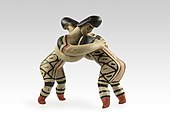
Statuette Karajà, wrestlers - Muséum de Toulouse (MHNT)
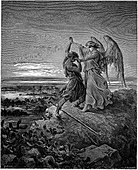
Jacob Wrestling with the Angel illustration by Gustave Doré (1855)

Michiel Sweerts, Wrestling Match, 1649

Tibetan wrestlers in 1938
Indian wrestler exercising near Varanasi, 1973
Modern international disciplines
Wrestling disciplines, as defined by UWW, are broken down into two categories: International wrestling disciplines and folk wrestling disciplines. UWW currently recognizes six wrestling disciplines in all. Three are Olympic disciplines: Greco-Roman wrestling, men's freestyle wrestling and female wrestling (i.e. women's freestyle wrestling). The other three are amateur pankration, belt wrestling alysh and beach wrestling.[12]
Greco-Roman
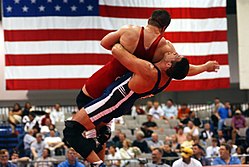
Greco-Roman is an international discipline and an Olympic sport. In Greco-Roman style, it is forbidden to hold the opponent below the belt, to make trips, and to actively use the legs in the execution of any action. Recent rule changes in Greco-Roman increase opportunities for and place greater emphasis on explosive, 'high amplitude' throws. Pinning one's opponent to the mat is one way of winning. One of the most well known Greco-Roman wrestlers is Alexander Karelin from Russia.
Freestyle wrestling
Freestyle wrestling is an international discipline and an Olympic sport, for both men and women. This style allows the use of the wrestler's or his opponent's legs in offense and defense. Freestyle wrestling has its origins in catch-as-catch-can wrestling and the prime victory condition in this style involves the wrestler winning by throwing and pinning his opponent on the mat. American high school and men's college wrestling is conducted under different rules and is termed scholastic and collegiate wrestling. American women's college wrestling uses freestyle rules.

Amateur pankration
Pankration, from the Greek words pan and kratos and meaning "all of power", is a world heritage martial art which was introduced to the Ancient Olympic Games in 648 BC. Modern amateur pankration is a form of mixed martial arts (MMA) that incorporates techniques from multiple systems. Matches are fought with both grappling holds and by striking techniques.[13]
Belt wrestling alysh
Alysh is a Turkic term for a Central Asian folk wrestling style which involves the wearing of jackets, trousers and thick belts. Throughout the contest the wrestlers must retain their hold on each other's belt. For this reason it is also referred to as 'belt wrestling alysh' or 'alysh belt wrestling'.
Beach wrestling
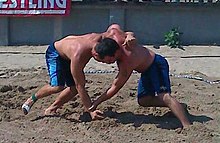
UWW, then known as FILA, codified the form of beach wrestling in 2004.[14] Beach wrestling is standing wrestling done by wrestlers, male or female, inside a sand-filled circle measuring 7 meters (23 ft) in diameter. The style originally mirrored the rules used before the use of wrestling mats,[15] and beach wrestling has been regarded as the oldest version of international competitive wrestling.[16] The wrestlers wear swimsuits rather than special wrestling uniforms. Wrestlers may also wear spandex or athletic shorts.
The international rules have been modified in 2015 by UWW, with the current rules allowing wrestlers to score points via takedowns, pushing their opponent out of bounds, or bringing the opponent down to their back.[17] In addition to the annual World Beach Wrestling Championships, beach wrestling has been contested at Youth Olympic Games, Asian Games, Down Under Games, Mediterranean Games and at the 2019 World Beach Games.[18]
Folk styles
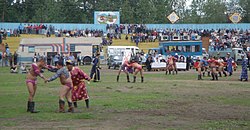
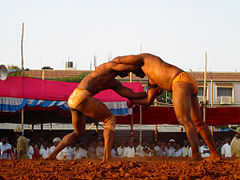
Folk wrestling describes a traditional form of wrestling unique to a culture or geographic region of the world that FILA does not administer rules for. Examples of the many styles of folk wrestling, include Cornish wrestling, backhold wrestling (from Europe), Cumberland Wrestling and Catch-as-catch-can (from England), kurash from Uzbekistan, gushteengiri from Tajikistan, khuresh from Siberia, Lotta Campidanese from Italy, koshti pahlavani from Iran, naban from Myanmar, pehlwani from India, penjang gulat from Indonesia, schwingen from Switzerland, tigel from Ethiopia, shuai jiao from China, and ssireum from Korea.
Folk wrestling styles are not recognized as international styles of wrestling by UWW.
However, folk styles have been international in nature. For example there have been regular Cornish wrestling tournaments and matches in the US,[19] Australia,[20] South Africa,[21] New Zealand,[22] England[23][24] and Cornwall, with irregular tournaments and matches in Japan,[25] Canada[26] and Mexico.[27]
Oil wrestling
Oil wrestling (Turkish: yağlı güreş), also called grease wrestling, is the Turkish national sport. It is so called because the wrestlers douse themselves with olive oil. It is related to Uzbek kurash, Tuvan khuresh and Tatar and Bashkir көрәш (köräş). The wrestlers, known as pehlivanlar meaning "champion" wear a type of hand-stitched lederhosen called a kispetler, which are traditionally made of water buffalo hide, and most recently have been made of calfskin.
Unlike Olympic wrestling, oil wrestling matches may be won by achieving an effective hold of the kisbet. Thus, the pehlivan aims to control his opponent by putting his arm through the latter's kisbet. To win by this move is called paça kazık. Originally, matches had no set duration and could go on for one or two days, until one man was able to establish superiority, but in 1975 the duration was capped at 40 minutes for the başpehlivan and 30 minutes for the pehlivan category. If no winner is determined, another 15 minutes—10 minutes for the pehlivan category—of wrestling ensues, wherein scores are kept to determine the victor.
The annual Kırkpınar tournament, held in Edirne in Turkish Thrace since 1362, is the oldest continuously running, sanctioned sporting competition in the world. In recent years this style of wrestling has also become popular in other countries.
Collegiate wrestling

Collegiate wrestling (sometimes known as scholastic wrestling or folkstyle wrestling) is the commonly used name of wrestling practiced by men at the college and university level in the United States. This style, with modifications, is also practiced at the high school and middle school levels, and also for younger participants. The term is used to distinguish the style from other styles of wrestling used in other parts of the world, and from those of the Olympic Games: Greco-Roman wrestling, and Freestyle wrestling. Some high schools in the U.S. have developed junior varsity and freshman teams alongside varsity teams. Junior varsity and freshman wrestling teams restrict competitors not only by weight, but also by age and the amount of wrestling a competitor can partake in. For example, some junior varsity and freshman competitors are not allowed in tournament competition due to the amount of mat time a wrestler would accrue in a short time period.
Women's college wrestling in the U.S. does not use the collegiate ruleset, instead being conducted under standard freestyle rules.[28]
There are currently several organizations which oversee collegiate wrestling competition: Divisions I, II, and III of the NCAA, the NAIA, the NJCAA, and the NCWA. NCAA Division I wrestling is considered the most prestigious and challenging level of competition. A school chooses which athletic organization to join, although it may compete against teams from other levels and organizations during regular-season competition. The collegiate season starts in October or November and culminates with the NCAA tournament held in March.[29]
Professional wrestling
Professional wrestling is often concluded in a raised ring; akin to boxing. American and British professional wrestling was considered a genuinely competitive sport up until around the mid-1920s, with occasional shoot matches still occurring well into the 1930s and 40s. The roots of professional wrestling lay in the catch-as-catch-can contests of the late 19th century. Whereas the Europeans favored the more controlled and classical Greco-Roman style, the Americans preferred the more wide-open style of wrestling that later became known as freestyle. When the best American catch wrestlers discovered they could earn money with their skills, the professional counterpart was born. Initially, the contests were similar to amateur matches, except there were no time limits, and submission and choke holds were allowed. Amateur wrestling coexisted peacefully alongside its professional counterpart until around the 1940s before the sport grew more theatrical.[30] Wrestlers from this period were known as hookers or shooters due to their legitimate skills. Popular wrestlers from this era include Martin "Farmer" Burns, Frank Gotch, Tom Jenkins, Joe Stecher, Earl Caddock, Stanislaus Zbyszko, Ed "Strangler" Lewis, Ad Santel, John Pesek, Ray Steele, Richard Shikat and transitional figure Lou Thesz.
Modern day professional wrestling (also known as sports entertainment), although advertised as contests, are actually exhibitions with winners generally pre-determined to increase entertainment value.
Sports entertainment
Sometimes referred as "American-Style" professional wrestling, companies such as WWE, AEW, Impact Wrestling and ROH run touring professional wrestling events throughout the world. Matches are highly theatrical, with dramatic stories such as feuds between the athletes developed and performed as part of build-up and promotion for matches. Before its increase in popularity in the mid 1980s, professional wrestling in the United States was organised as a cartel of regional monopolies, known as "territories." Wrestling in some of these areas (particularly the Southern and Midwestern United States) was performed in a relatively less theatrical more serious style, which could vary from realistically sporting to darkly violent, depending on local preference.
British/European wrestling
A different style of professional wrestling evolved in the United Kingdom and spread across Western Europe (where it was known as "Catch" in the non English speaking countries of mainland Europe.) Traditionally in this style, there was less use of storylines and angles to promote the matches which, for the most part, had the atmosphere of real wrestling competition. In many countries such as the UK, this form of professional wrestling achieved mainstream popularity with television making household names of its stars, but later declined and was supplanted both on television and in wider culture by imported American wrestling. Some promoters in the UK (and to a lesser extent France and Germany) still produce live shows in this style but face stiff competition from more American-styled rivals.
Puroresu
Japanese professional wrestling, also known as puroresu, is also treated more as a sport than the entertainment style of wrestling common in North America. As with British/European wrestling, there are fewer and less contrived storylines and angles and there is a similar atmosphere of realistic sporting competition. Popular Japanese wrestlers include Rikidozan, Giant Baba, Antonio Inoki, Mitsuharu Misawa, Kenta Kobashi, Shinya Hashimoto and Keiji Mutoh.[31] Shoot style wrestling evolved from traditional puroresu in an attempt to create a combat-based style. Shoot style featured a mix of amateur and catch wrestling, kickboxing and submission grappling. Shoot style wrestling is retrospectively considered a precursor to mixed martial arts.
Lucha libre
Mexican professional wrestling, also known as lucha libre, is a style of wrestling using special holds. Most performers, known as luchadores (singular luchador), begin their careers wearing masks, but most will lose their masks during their careers. Traditionally a match involves the best of three rounds, with no time limit. Each luchador uses his own special wrestling style or "estilo de lucha" consisting of aerial attack moves, strikes and complex submission holds. Popular luchadores in Mexico and Puerto Rico are El Santo, Blue Demon, Mil Máscaras, Perro Aguayo, Carlos Colón, Konnan, La Parka and Místico. Several wrestlers who performed in Mexico also had success in the United States, including Eddie Guerrero, Rey Mysterio (Jr.) and Dos Caras Jr./Alberto Del Rio.
Circus wrestling
In France in the 19th century, early professional wrestling shows in the Greco-Roman style were often performed at the circus by the resident strongmen. This style later spread to circuses in Eastern Europe, particularly in Russia where it was a staple part of circuses in the Soviet era, where it was often advertised as "French wrestling."[32] Ivan Poddubny achieved major stardom in his homeland and beyond during the interwar period.
Judo
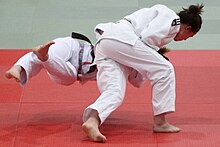
Judo is a style of wrestling which is derived from Jujitsu, a Japanese martial art. As a wrestling style Judo is distinctive in that its practitioners (judokas) wear trousers and a thick jacket and belt (judogi). These suits can be grabbed in order to throw or pin an opponent etc. Judo also allows locks and chokes although these may be restricted or banned outright for juniors.[33] Judo is a popular sport in Japan. Judo clubs (dojos) are also the most common wrestling type clubs in Western Europe and are often found in towns and cities.
Sambo
Sambo is a martial art that originated in the Soviet Union (specifically Russia) in the 20th century. It is an acronym for "self-defence without weapons" in Russian and had its origins in the Soviet armed forces. Its influences are varied, with techniques borrowed from sports ranging from the two international wrestling styles of Greco-Roman and freestyle to judo, jujitsu, European styles of folk wrestling, and even fencing. The rules for sport sambo are similar to those in competitive judo, with a variety of leg locks and defense holds from the various national wrestling styles in the Soviet Union, while not allowing chokeholds.[34]
Mixed martial arts

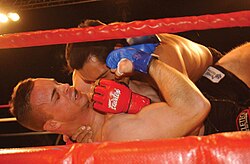
The rapid rise in the popularity of mixed martial arts (MMA) has increased interest in wrestling due to its effectiveness in the sport.[35] It is considered one of five core disciplines in MMA together with muay Thai,[36] kickboxing, judo[37] and Brazilian jiu-jitsu. Already in the early stages of MMA development, wrestling gained respect due to its effectiveness against traditional martial artists. Wrestlers, Dan Severn, Don Frye, Mark Coleman, Randy Couture and Mark Kerr went on to win early Ultimate Fighting Tournaments. Ken Shamrock won the first UFC Superfight Championship in the UFC and was also the first King of Pancrase in Japan.
UFC color commentator Joe Rogan stated: “I personally think that the very best skill for MMA is wrestling, I think that's the number one base to come from because those guys just flat out dictate where the fight takes place [standing or on the ground]." "There is no better base for entering into mixed martial arts than the highly successful competitor as a wrestler. The competitive wrestlers, the highly successful amateur wrestlers have such tremendous mental toughness. If you can just get through the room, the wrestling room practices at like really high level universities, NCAA division one teams; those guys are savages. The stuff they go through, just the overtraining, just the mental toughness that you have to develop."[38][39]
Successful fighters in modern MMA who began their training in various forms of wrestling include former UFC Lightweight Champion Frankie Edgar, 2000 Olympic silver medalist Yoel Romero, 2009 world champion and former ONE FC Welterweight Champion Ben Askren, former Olympic wrestler and former UFC Light Heavyweight and Heavyweight Champion Daniel Cormier, 2008 Olympic Gold medalist and former UFC Flyweight Champion and Bantamweight Champion Henry Cejudo and former Pride FC Middleweight and Light Heavyweight Champion Dan Henderson, who competed extensively in collegiate and Greco-Roman wrestling before beginning his career in mixed martial arts.[40]
See also
- Amateur wrestling
- List of famous amateur wrestlers
- List of World Champions in Men's Freestyle Wrestling
- Aquathlon (underwater wrestling)
- Arm wrestling
- Catch wrestling
- Indian wrestling
- Grappling
- Malla-yuddha
- Mixed martial arts
- Pankration
- Professional wrestling
- List of professional wrestlers
- WrestleMania
- Skin infections and wrestling
- Sumo
- United World Wrestling (UWW)
- Wrestling at the Summer Olympics
References
- ^ "Different types of wrestling". 14 February 2013.
- ^ OED; see also Dictionary.com. "Wrestle". dictionary.com. Retrieved 2007-10-08.
- ^ New International Version Genesis 32:24-32
- ^ "The Historical origins of Wrestling". collegesportsscholarships.com. Retrieved 21 November 2010.
- ^ Salamone, Frank (2013). The Native American Identity in Sports. Rowman & Littlefield. p. 123. ISBN 9780810887084.
- ^ Miller, Christopher. "Submission Fighting and the Rules of Ancient Greek Wrestling". Retrieved 2007-10-08.
- ^ Jump up to: a b "Wrestling, Freestyle" by Michael B. Poliakoff from Encyclopedia of World Sport: From Ancient Times to the Present, Vol. 3, p. 1193, eds. David Levinson and Karen Christensen (Santa Barbara, CA: ABC-CLIO, Inc., 1996).
- ^ Jump up to: a b "Wrestling, Freestyle" by Michael B. Poliakoff from Encyclopedia of World Sport: From Ancient Times to the Present, Vol. 3, p. 1190, eds. David Levinson and Karen Christensen (Santa Barbara, CA: ABC-CLIO, Inc., 1996).
- ^ Encyclopædia Britannica, 1981, p. 1026.
- ^ International Federation of Associated Wrestling Styles. "Greco-Roman Wrestling". FILA. Archived from the original on 2011-07-11. Retrieved 2007-08-09.
- ^ "Wrestling, Greco-Roman" by Michael B. Poliakoff from Encyclopedia of World Sport: From Ancient Times to the Present, Vol. 3, p. 1194, eds. David Levinson and Karen Christensen (Santa Barbara, CA: ABC-CLIO, Inc., 1996).
- ^ "Disciplines". United World Wrestling. Retrieved 31 October 2014.
- ^ "Pankration". FILA. Retrieved 2011-07-28.
- ^ 'Beach Wrestling " Archived 2012-10-24 at the Wayback Machine, fila-official.com
- ^ Teet, Rob (2016-03-07). Hosting Beach Wrestling Events on Google Books. ISBN 9781329956216. Retrieved 14 December 2016.
- ^ "SandWrestling.com". Archived from the original on 23 October 2016. Retrieved 14 December 2016.
- ^ "Beach Wrestling Rules Adjusted". United World Wrestling. Retrieved 14 December 2016.
- ^ "UWW Disciplines". Retrieved 15 December 2016.
- ^ Great activity in wrestling, Cornish sport is growing in popularity in upper peninsula of Michigan, The Minneapolis Journal, 19 July 1902, p9.
- ^ Wrestling, Bendigo Advertiser (Vic), 9 January 1906, p3.
- ^ Cornish Association of South Africa, Cornish Guardian, 8 May 1914, p5.
- ^ Wrestling for the championship of Westland, WEST COAST TIMES, ISSUE 712, 4 JANUARY 1868, p2.
- ^ Cornish wrestling in Devon, Cornish Guardian, 25 June 1926, p6.
- ^ Last Christmas Day wedding in Taunton, Taunton Courier, and Western Advertiser, 28 December 1963, p1.
- ^ Wrestling, The Japan Weekly Mail, 30 March 1872, p162.
- ^ Cornish Wrestling to be introduced to Canada, Cornish Guardian, 20 December 1928, p5.
- ^ A Cornish Wrestler in Mexico, The Cornish Telegraph, 14 July 1892, p5.
- ^ "Growing Wrestling: Women's Collegiate Wrestling Association". National Wrestling Coaches Association. Retrieved June 23, 2020.
- ^ "Wrestling, Freestyle" by Michael B. Poliakoff from Encyclopedia of World the Sport: From Ancient Times to the Present, Vol. 3, p. 1192, eds. David Levinson and Karen Christensen (Santa Barbara, CA: ABC-CLIO, Inc., 1996).
- ^ Chapman, Mike (1990). Encyclopedia of American Wrestling. Champaign, Illinois: Leisure Press. pp. 1–2. ISBN 9780880113427.
- ^ Wilson, Kevin. "Legends". Puroresu Central. Retrieved 2009-07-26.
- ^ Art Ukraine.com - Posters for State Circus in Ukraine advertising "French Wrestling" (professional Greco Roman wrestling) - Accessed 17 June 2018
- ^ Schrag, Myles (2018). 'Judo' in 'The Sports Rules Book'. Human Kinetics. ISBN 1492572829.
- ^ International Federation of Associated Wrestling Styles. "Sambo". FILA. Retrieved 2007-08-09.
- ^ "Can mixed martial arts save wrestling?". USATODAY.COM.
- ^ WTBA Administrator (April 29, 2018). "History". thaiboxing.com. Archived from the original on June 30, 2015.
- ^ "The Gentle Way Part II: Olympians Ronda Rousey and Rick Hawn Adapt to MMA". Bleacher Report. Archived from the original on March 5, 2016. Retrieved January 19, 2015.
- ^ "Rogan: The very best skill for MMA is wrestling". The Underground. 19 May 2010.
- ^ "UFC® FIGHT PASS™ - Chael Sonnen vs. Nate Marquardt UFC 109". UFC.TV.
- ^ Coach Mike R (11 August 2013). "Factgrinder: The 25 Greatest Wrestlers in UFC History". Bloody Elbow.
Notes
- ^ Exbroyat of Lyon. He died in 1868. Another claim, is that the founder of Greco-Roman wrestling, was Frenchman Jean Broyasse (death 1872), according to the encyclopedia Gyldendals store konversasjonsleksikon, 1981, p. 2564.
External links
| Look up Wrestling or Grappling in Wiktionary, the free dictionary. |
| Wikimedia Commons has media related to Wrestling. |
| Wikimedia Commons has media related to Women's Wrestling. |
- Wrestling
- Ancient Olympic Games
- Mixed martial arts styles
- Summer Olympic sports





